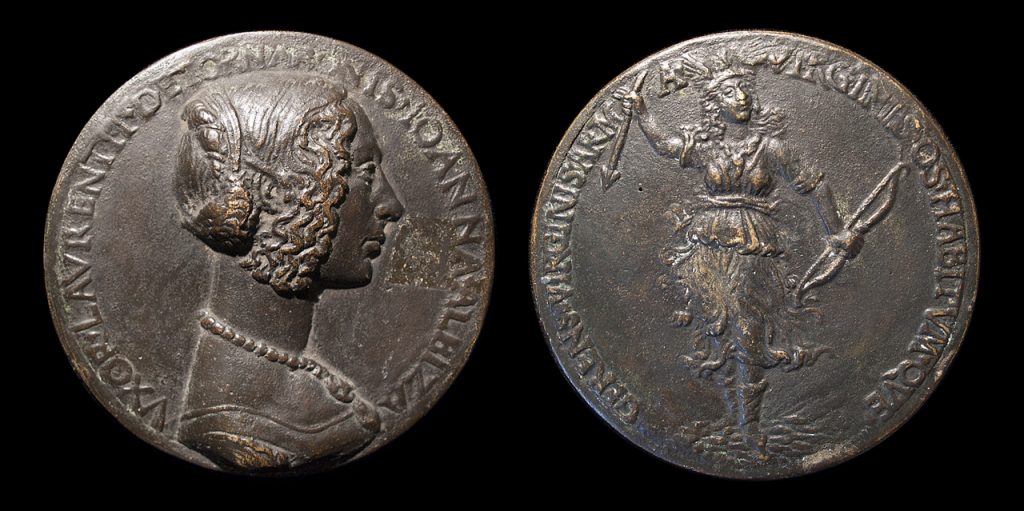- Personage:
-
Tornabuoni (Giovanna degli Albizzi)
Giovanna degli Albizzi, wife of Lorenzo Tornabuoni.
- Artist:
-
Niccolò di Forzore Spinelli (Niccolò Fiorentino)Niccolo di Forzore Spinelli, called Niccolo Fiorentino, Niccolo di Forzore, di Niccolo, di Luca Spinelli.
—
A grand-nephew of the painter Spinello Aretino, was born in Florence, of a family of goldsmiths of the Popolo of S. Maria Novella, on 23 Apr. I430, and died there in April 1514. He married in 1471 Alessandra di Lionardo de’ Paoli. It is probable that he is identical with the ‘Nicolas de Spinel’ who is mentioned in 1468 in the accounts of the Dukes of Burgundy as having engraved seals for Charles the Bold. In 1484 he repaired and restored the great silver seal of the Arte de’Giudici e Notai of Florence.
- Description:
-
Obverse: · VXOR · LAVRENTII · DETORNABONIS · IOANNA · ALBIZA · Bust facing right; hair in curls covering cheek and coiled in braid at back; wears low-cut bodice and necklace with quatrefoil jewel and large pendant pearl.
Reverse: · VIRGINIS · OS · HABITVM · QVE · GERENS · E · VIRGINIS · ARM A · Giovanna as Venus in the guise of a Spartan huntress; Wears high winged cap, girdled tunic, and boots, and advances to front on a radiant cloud, looking up three-quarters to right, quiver at her waist; she holds an arrow in her right hand, a bow in her left.
- Background:
-
Presumably, as Giovanna is quite young, this was made either for, or very soon after, her 80 mm. Bronze cast.marriage to Lorenzo in 1486.
A number of women were honored with medals, many of which were ordered as part of the rituals of engagement and marriage. The medal of Giovanna degli Albizzi was commissioned about 1486, most likely by her husband-to-be, the well-connected and prosperous Lorenzo Tornabuoni, who was also a poet and literary scholar, to celebrate their forthcoming marriage. The portrait image on the obverse shows her wearing a necklace of pearls, the traditional adornment of brides. The image chosen for the reverse draws on the antique imagery of the Three Graces, interpreted here, as the inscription makes clear, in terms of the three key concepts attached to the Renaissance woman: CASTITAS, PVLCHRITVDO, and AMOR (Chastity, Beauty, and Love). The Three Graces are shown as three elegant nude women—types of the goddess Venus—entwined in a circular embrace that gives prominence to each.
- Diameter:
- 80 mm. Bronze cast.
- Evaluation:
- Good patina, some wear; Likely original cast.
- Reference:
- Hill 1022; Arm I, 89, 21.
